As a big fan of 7TV: Inch High Spy-Fi, I was very excited to see Crooked Dice’s latest spin-off from the great 7TV system. After forays into the Pulp and Apocalypse genres, both of which are based fairly closely on Inch High Spy-Fi, the leap into the fantasy genre is now a bit bigger. I enjoy playing fantasy settings, coming from Warhammer Fantasy and have felt very comfortable in the Lord of the Rings tabletop. After a positive experience with Inch High Spy-Fi, I was eager to see what the system would produce in my favorite setting.
The idea behind the 7TV game is that in the game you reenact the shooting of a movie or a TV episode. The subtitle gets to the point:
Cinematic Skirmishing in Fantasy Worlds
These are figure agnostic systems, so you can play with whatever seems appropriate. Crooked Dice offers its own miniatures in each case, of course, but everything else is just as possible. Where “Spy-Fi” reminds you of James Bond, “Pulp” has a clear Indiana Jones vibe and “Apocalypse” is unthinkable without Mad Max, “Fantasy” makes you think of Conan, Xena and the like. Of course, 7TV Fantasy is based on the fantasy movies of the 80’s and early 90’s, before the genre was considered dead for a few years. The TV series about Hercules and Conan were a bit more long-lived, but after that it was over for many years. Most of the representatives of this genre were trashy and far away from the high class productions of our time. Of course, 7TV Fantasy also plays with that.
In all games, the rules corset is kept as flexible and generic as possible. In Fantasy, you can play with a cast of heroes of your own devising, but you can also use your miniatures from Middle Earth, Game of Thrones, or other franchises. I’m looking forward to building a cast of Aragorn, Legolas, and Gimli and slashing my way through a group of orcs in search of hobbits.
Since I think that 7TV definitely needs to be made more known in Germany, I would like to introduce the “Fantasy” box here.
Inside the box
All current 7TV boxes use the rules of the 2nd edition. The basic mechanics are the same and the boxes are designed similarly. I like that all the boxes are designed accordingly and you get a feel for the setting just from the game materials. In 7TV Fantasy everything is possible, but the design is clearly about High Fantasy: We see elves and dwarves, fearsome skeleton warriors and dragons. All the game components are designed accordingly without relying too much on a specific movie. I like that. Alright, so let’s take a closer look at the box:
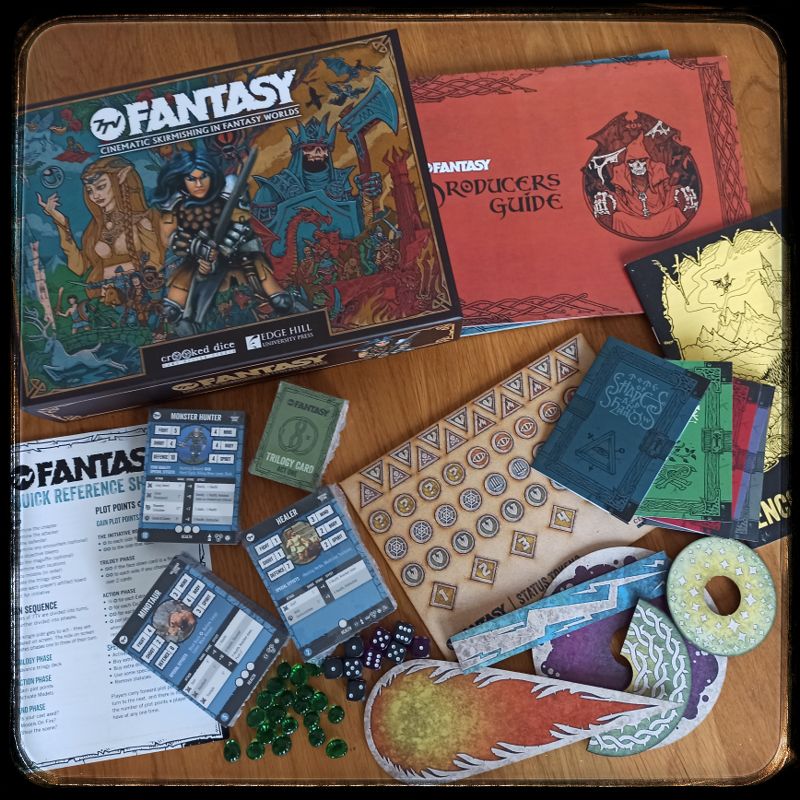
Like all other 7TV boxes, this box contains the necessary game materials. In addition, you only need a measuring instrument in inches and, of course, the miniatures. Additional W6 dice can’t hurt either. Miniatures are not included in the boxes, but you can play with anything you like. Crooked Dice now has a wide range of suitable figures with pop culture references. For example, the box release included miniatures with references to Xena or The Witcher, as well as a variety of generic heroes and enemies. I’m sure the vast majority of readers will already have their own fantasy models that can be used right away.
So what exactly is in the box?
Specifically, the box contains the Director’s Guide (rulebook), the Producer’s Guide (a kind of sourcebook to design the games), the Casting Guide (a sourcebook to assemble the game characters), the Encounter Guide (for random non-player encounters with monsters or the like. ), a Quick Reference Sheet (a quick summary of the most important terms), a stack of Heroes, Villains and Monster Profile cards, a stack of Trilogy cards, a stack of Maguffin cards, a stack of Artifact cards, counters, MDF markers, dice and MDF templates for various effects. Phew, that’s a whole lot of paper and odds and ends.
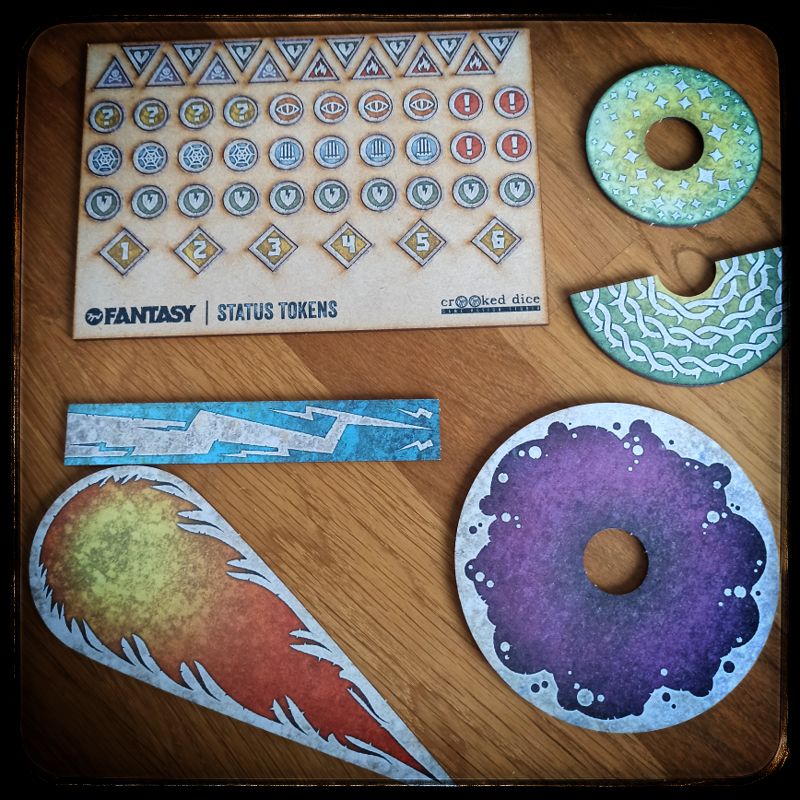
All parts are processed in high quality, made of strong glossy paper, cardboard and MDF (templates) or glass (counter). The box itself is made of very sturdy cardboard and makes a valuable impression. I like the design very much. I find it especially nice that the books once again contain a large number of scenic photos by master painter and photographer Kevin Dallimore. They show a wide variety of encounters inspired by fantasy films and are pleasingly often reminiscent of Ray Harryhausen’s best moments. This time around, some of the cards strike me as relatively small and thin for the first time – the Trilogy cards, for instance. Given that they are picked up several times in each game, I have my doubts about their longevity. Wear and creases seem likely to me. You may have to protect them better, but that would take some effort given the number. Maybe my impression is deceiving me, but I wanted to mention it because I am otherwise very satisfied with the quality.
Compared to 7TV Inch High Spy-Fi, the number of materials has increased once again. There are more cards in the game and even the reference books have become more. However, this does not automatically mean higher complexity. The relatively high number of cards is not completely needed in the game. The Directors and the Casting Guide equip one with the rules and everything worth knowing about the game.
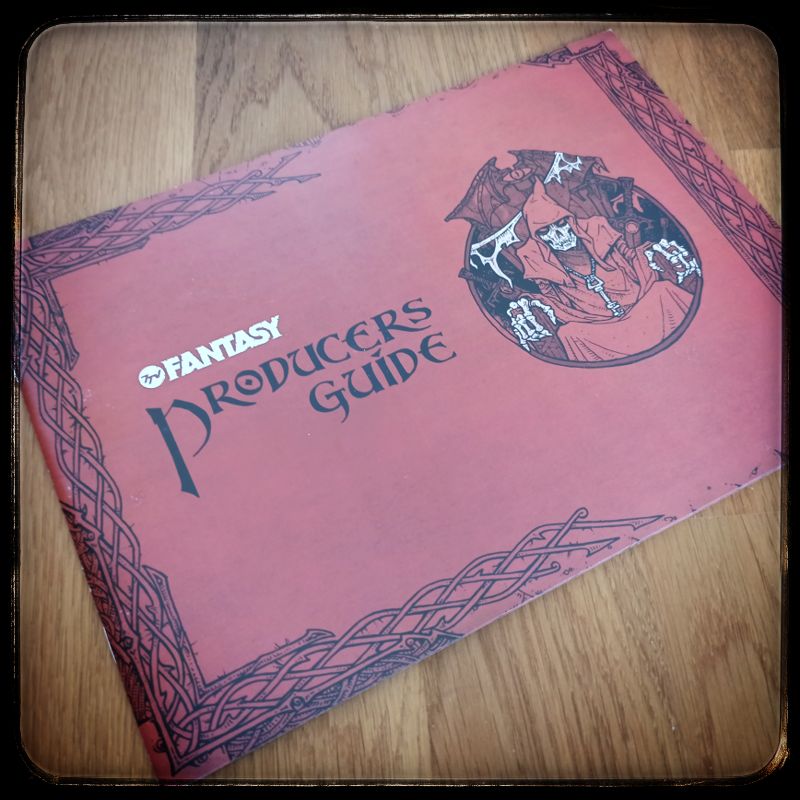
The Producers Guide contains a novelty: it deals entirely with reenacting a cinematic game. For this, it is also suggested to choose one of 7 scenarios by rolling the dice, ranging from combat to escape to theft. A number of examples of classic fantasy movies help one to create the games. The guide could be neglected, but it is part of the fun and a lot of love and nerd knowledge has gone into it. This is already noticeable by the fact that the first four pages are taken up by the fictional movie review of the fictional DVD box set “Bear and Wolf Saga” including the great, but equally fictional “Orso the Fearless”. This is fun and encourages the user to create his own game. Here you can clearly feel that Crooked Dice was assisted in the development by students of a creative writing course. As a film fan, this makes my heart swell!
Of the many other cards, you select only those that will be used in the game, such as the profile cards of the heroes. The Trilogy deck has actual relevance for the game. We’ll get to how that works now:
The rules
At its core, 7TV: Fantasy is a classic 28mm skirmish with 5-10 miniatures per side. Larger games are also possible, but rather no mass battles are played. As already mentioned, you don’t play a real conflict, but you are in the middle of shooting a TV episode. Your own miniatures are therefore divided into “star”/main actor, “co-star”/important supporting actor and “extras”/secondary actor/statistician. The group results in the “cast”, abilities are “special effects”, special skills of your stars are “star qualities”, the point value of your cast is measured as “rating”, the game itself is called “chapter” and the player whose turn it currently is is “on screen”. These designations, not relevant to the game itself, add nicely to the atmosphere. It’s actually worth taking on the role of producer.
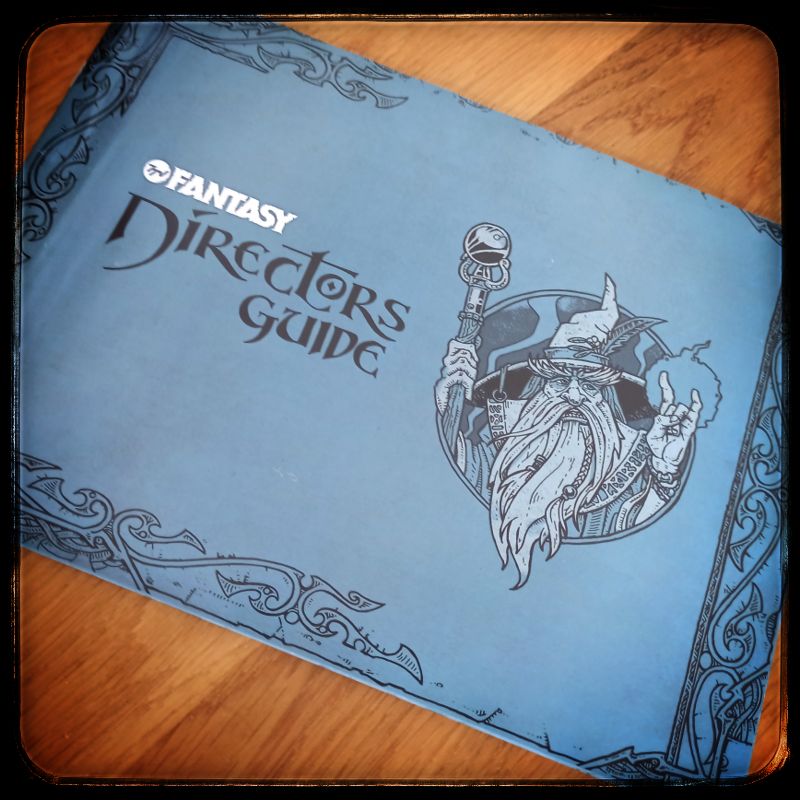
The movement and action rules correspond as far as possible to common skirmish rules. The models can interact almost freely with the environment: Run, climb, swim, enter buildings, etc. The players move one after the other and act out the complete turn before it is the other player’s turn again. The turn is divided into three phases: 1st Trilogy Phase, 2nd Action Phase, 3rd End Phase.
Innovation!
The Trilogy Phase features one of two innovative game elements: the Trilogy cards. They are divided into “Act One”, “Act Two” and “Finale” and provide the game with the spice of a dramatic TV episode. Act One symbolizes the beginning of a TV episode, where it’s more about movement and positional play. Act Two gets down to the nitty gritty: the cards deal primarily with action. The final cards make the end of the game a bit unpredictable – after all, when the heroes infiltrate the enemy hideout, anything can happen!
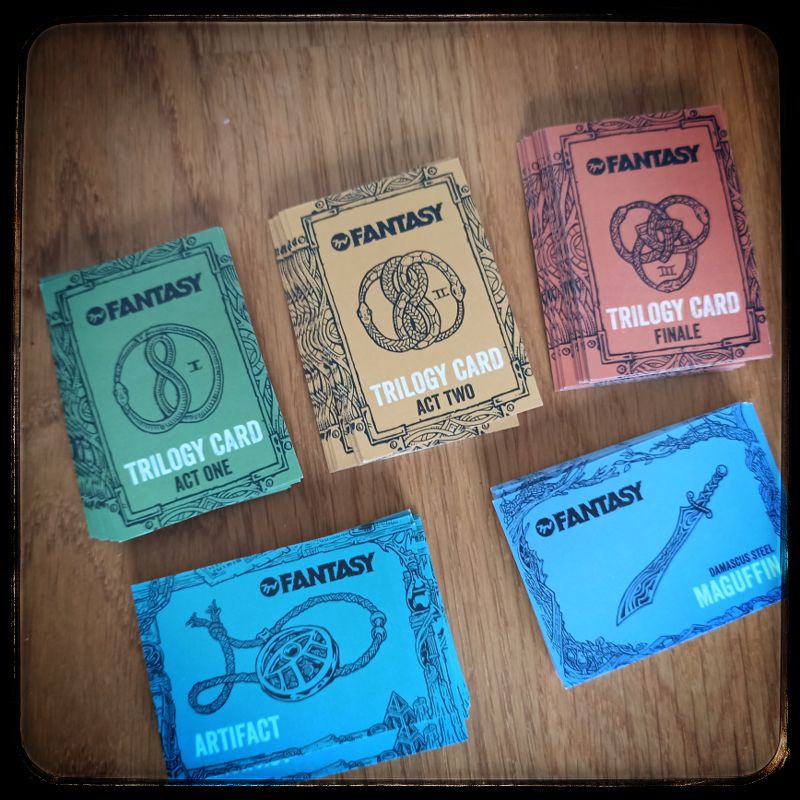
The cards are shuffled within their act and then discarded face down in the order 1-2-Final. Players draw one or two cards from the top of the pile at the beginning of the Trilogy phase, in the latter case only the second card is played and the first card is ignored and discarded. When the entire Trilogy pile is empty, the game is over. So by drawing two cards you can speed up the game and get to the second act or the finale faster.
The second innovative game element is the Plot Points. This is a point system that primarily affects the activation options on one’s turn. The models on the board generate Plot Points, drawing a Finale card generates Plot Points, winning or losing the initiative roll before the game starts also generates some. So the number of Plot Points varies each turn. You represent the Plot Points e.g. with the glass stones from the box and thus get a number every turn, which you can now spend on activations and special actions. So there is a certain random element to how many actions you can do per turn.
A nice idea I find is that each side can announce “steal the scene” once in the game. At the end of the turn you declare this and can immediately add a second turn, but you generate less plot points for it in the following turn. You can’t steal the scene in the final phase.
The bottom line is that 7TV: Fantasy offers varied and witty exciting rounds with simple action rules, but with a lot of possibilities. Up to this point, the game basically works like the other variants of 7TV.
Magic and monsters!
A specific novelty are the magic and the Encounter rules. Of course, High Fantasy settings without magic are unimaginable. Accordingly, the own heroes have magic abilities, magic items or are even wizards. In 7TV: Fantasy this is handled quite slimly and represented by 6 magic books, called “Grimoires”. The magic books define a selection of certain spells, as some may know it from earlier magic lore in Warhammer.
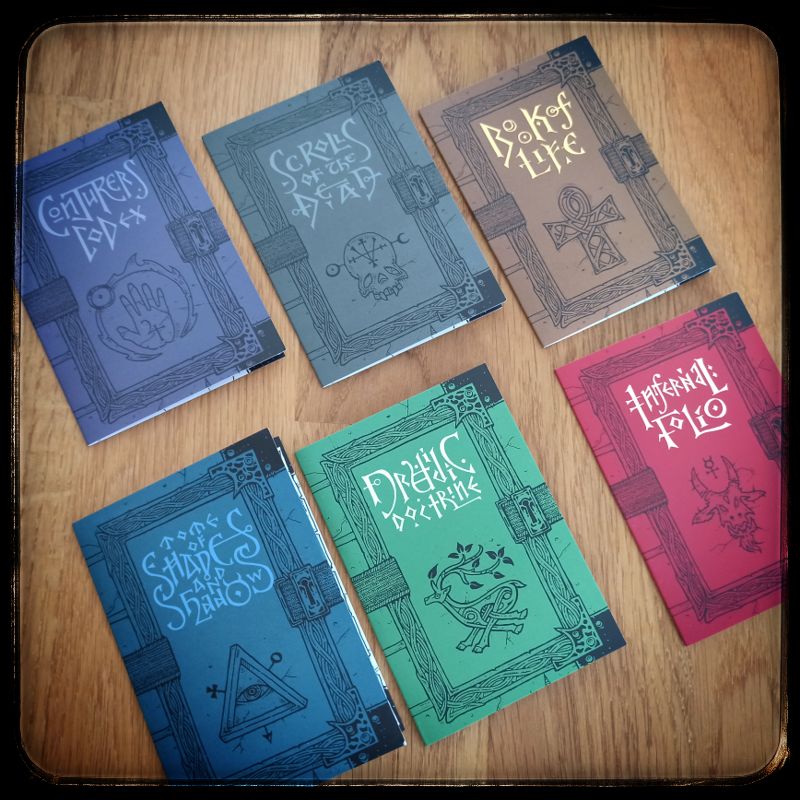
Another element that I like very much is the Encounters Guide. It is assumed that our game takes place in a fantastic world, where two conflicting parties in a dispute over a magical treasure can be disturbed by a nasty surprise at any moment. Maybe we didn’t know that our quest has led us into the middle of a gigantic spider’s lair? Maybe a large cyclops or a group of trolls burst into the middle of our gore? The Encounter Guide covers all of this, but it is explicitly a bonus. Those who want to spice up their game can do so now. Those who want to fight out a classic battle between two parties can just as easily do without this element. Nice idea that provides a lot of atmosphere if you want.
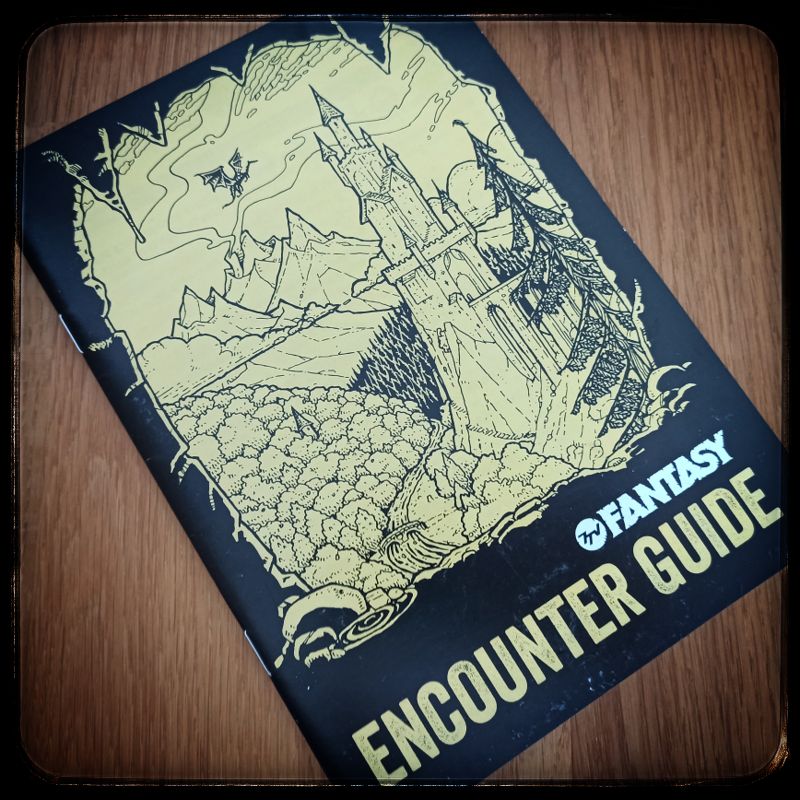
The Casting Guide
The classic army formation/list is handled in 7TV with the composition of the cast. The total number of all stars, co-stars, extras and co results in the rating, which must correspond to that of the opposing cast. There are heroic and villainous casts, from which you can choose more or less freely. Heroic casts tend to have more stars and co-stars, villainous casts tend to have simple but numerous henchmen. Sure, we have the heroic troop on one side and a bunch of orcs, goblins or skeletons around a powerful leader on the other.
The casting guide leads you through the numerous options for the composition of the cast. For example, the heroic cast can be led by the Brooding Barbarian, the Divine Mortal or the Tragic Hero. On the villainous side, it could be the Ambitious Usurper, the Vile Necromancer or the Wolfish Warlord. Finally, the options for extras span several pages and offer everything from Dwarves and Giant Eagles to Demons and Ghouls.
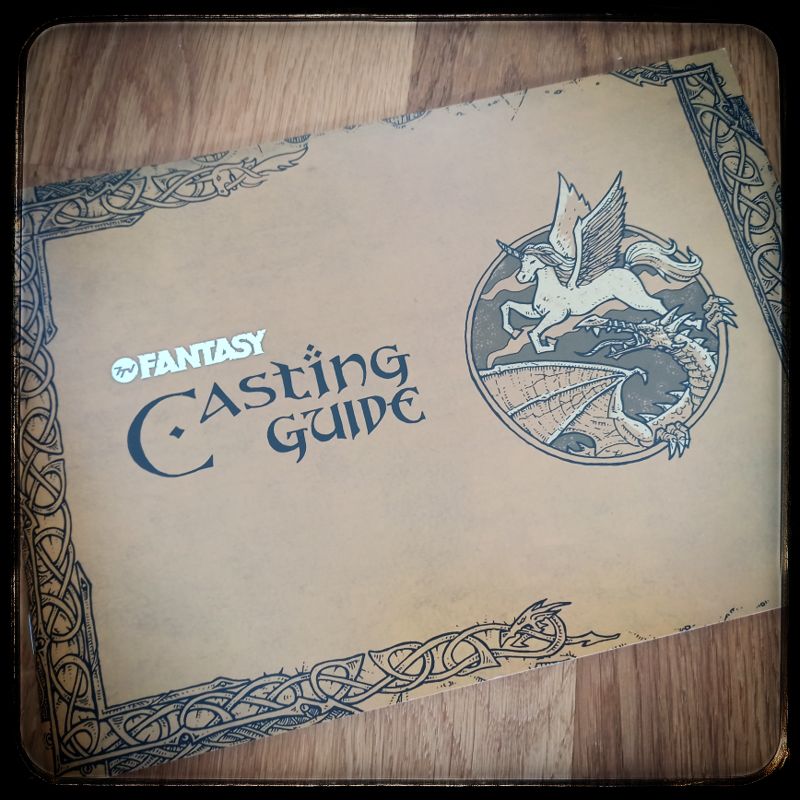
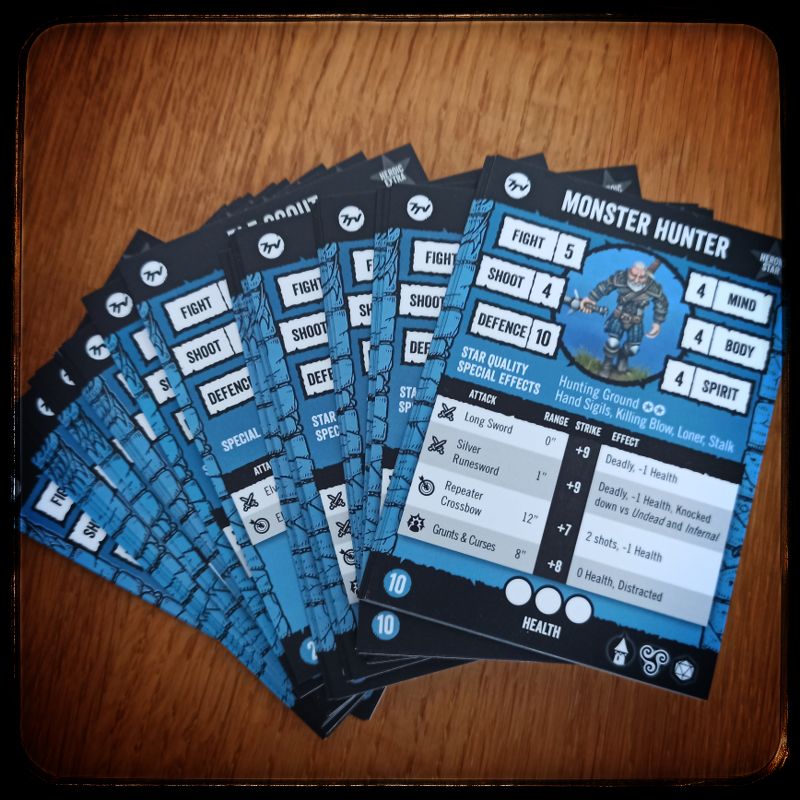
This time also with Quick Reference Sheet
As coherent as all the rules and mechanisms are, it is still a plethora of rules. The fluffy renaming of many terms can be an additional hurdle to memorization. All the more it is to be welcomed that Crooked Dice this time includes a six-page Quick Reference Sheet. This way you can see at a glance under which circumstances Plot Points are generated, what actions an activated model has, how magic is handled, how to roll for attack and defense and what effects there are. That makes a lot of things easier.
Conclusion
The 7TV: Fantasy Box is an all-around great starter set. It is flexible to use and you can replay your favorite movies and series or just be creative with a handful of old Warhammer, Confrontation or DSA miniatures.
Unfortunately, all boxes are not cheap. The Fantasy Box costs 60 pounds, but only the above mentioned components are included, no miniatures. The box is not a starter set in the sense that you have to buy additional items to be ready to play. If you already have a small stock of suitable miniatures, you can of course start right away. Otherwise, you can easily get inspired and buy what you like. The Crooked Dice boxes are high quality made, great designed and quality for the money, but they are still comparatively expensive. If you don’t want to pay shipping and tax from the UK, you can find them in Germany at e.g. Battlefield Berlin or Miniaturicum.
I think 7TV: Fantasy is a brilliant game, but in my opinion it has far too little awareness in Germany. Certainly the language barrier is a factor, but a translation is certainly not to be expected. If you don’t mind English rules, I’m happy if you take a look. Questions or other feedback are welcome in the comments!
